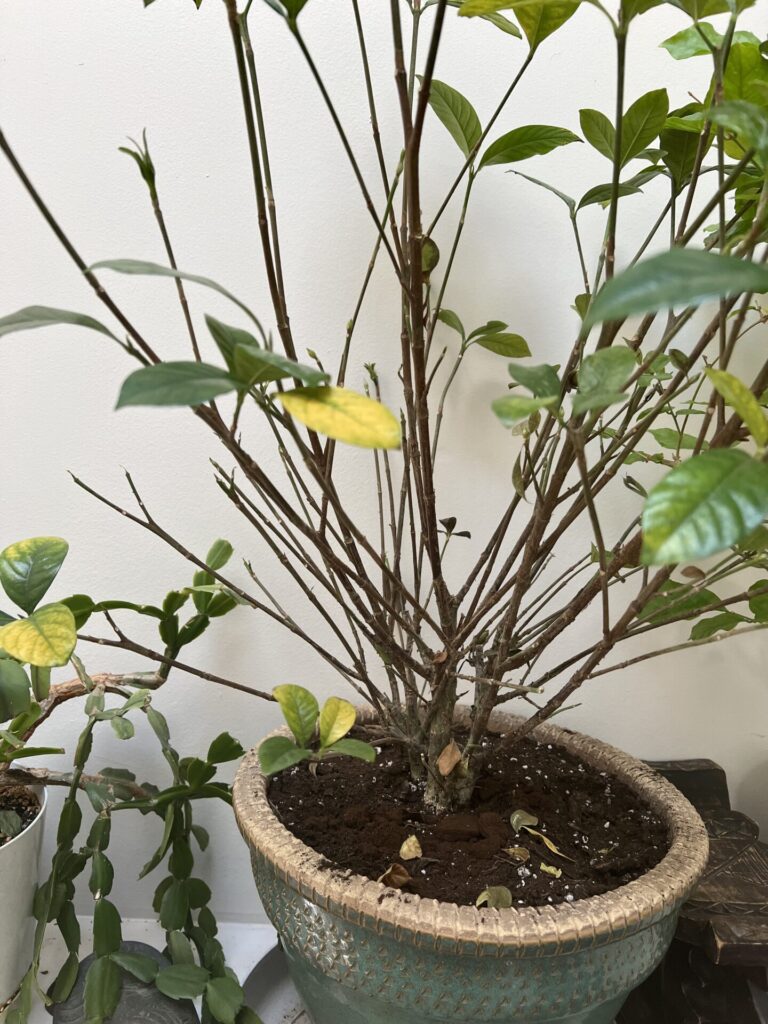
Hello. I have questions about these two plants.
I have had the Cleodendrum plant for many years and this winter it seems to be struggling. Many of the leaves have turned yellow and have fallen. I land it does not seem to be growing as well as it has in the past. It is on a ledge below a sky light where it has been for years. There’s plenty of light but not a lot of direct sun. I did cut it back at the end of the summer but haven’t since.
The gardenia is new to me. I bought it last summer. It is also losing a lot of leaves and they are turning yellow. I thought it might be cold (it was close to a north facing window) and I also thought I might have been over watering. I have backed off in the watering and have moved it onto the ledge below the skylight. Both plants are on the same ledge.
I toyed with repotting but I understand that you shouldn’t repot if plants are already under stress. Any advice you might have for me would be much appreciated.
Dear Gardener
Thank you for contacting Toronto Master Gardeners about leaf drop of your Cleodendrum and Gardenia. Cleodendrum (botanical name – Clerodendrum thomsoniae; common name – Bleeding heart vine) is native to Tropical western Africa and is commonly used as a houseplant or an annual in Hardiness Zone 6a. It requires moderate maintenance preferring part shade and medium level of moisture. Some leaf drop is common as it enters winter dormancy. During this time, water just enough to keep the soil from drying out and avoid fertilizing until new growth is seen in early spring.
Your success with it over the years, would suggest that its growing conditions are meeting its needs. You did not mention the fertilizing routine used during the growing season so you may wish to review fertilizer application recommendations for flowering potted plants. A possible cause of the Cleodendrum not doing well is salt injury from either watering or fertilizers; please see Watering Indoor Plants. This plant is also susceptible to spider mites and mealy bugs.
Gardenia (botanical name – Gardenia jasminoides; common name – common gardenia or cape jasmine) is native to southern China and Japan. This high maintenance beauty also requires part shade and medium level of moisture. However, it also requires an acidic potting soil and fertilizer during the growing season. Hard water, too alkaline soil or lack of iron will result in yellow leaves (chlorosis). Gardenias easily respond to changes in growing conditions such as lighting, drafts, temperature, etc. by dropping their leaves. From your image, most of the remaining leaves look fairly dark green as the grower would have potted it in the correct mix. For repotting, you would choose a lower pH soil that is suitable for Azaleas and Rhododendrons. Gardenias are susceptible to various plant problems such as powdery mildew, leaf spots, dieback, anthracnose, sooty mold, whiteflies, mealybugs, scales, aphids and spider mites.
Both watering issues and pest problems are the most common causes of plants not doing well. Common pests, as listed above, include spider mites, scale and mealy bugs. As for pest problems, identification is necessary. You will need a magnifying glass to determine if the cause of leaf drop is due to insects. Management depends on the type of insects identified
You have suggested the possibility of the plants being overwatered, which is a very common cause of plant demise. Please see Repotting & Fertilizing Houseplants for symptoms. It is suggested that you gently remove the plants from their pots to see the condition of the roots and look for signs of root rot: brown rather than white roots which are soft rather than firm and soggy soil which has a foul odour. The article, How to Identify and Treat Root Rot in Houseplants, identifies steps to treat root rot, however root rot treatment may be unsuccessful.
For further information, please refer to: Problems Common to Indoor Plants and Gardenia Diseases & Other Problems
Wishing you every success in restoring your plants to health!

